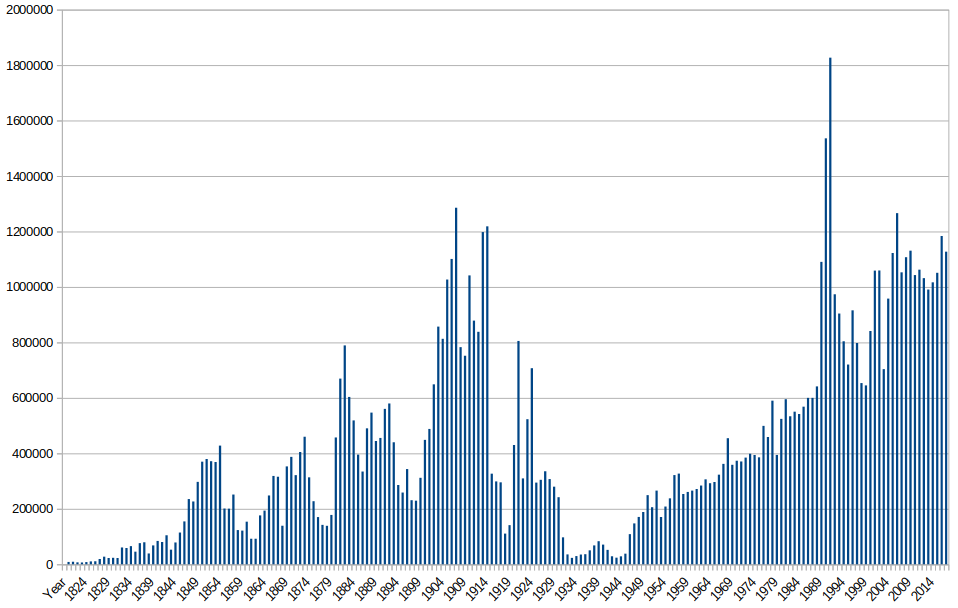The Impact of Immigration
by John Walker
[email protected]
Special to L. Neil Smith’s The Libertarian Enterprise
Here is a chart of the absolute number of immigrants admitted to the United States as permanent residents for the years 1820-2017 according to the U.S. Department of Homeland Security Yearbook of Immigration Statistics 2017. (Click on these charts to expand to full resolution.)
I’m sure you’ve seen a chart like this before, which shows a series of waves of immigration punctuated by gaps due to insurrections, changes in policy, economic crises, and wars which allowed assimilation of immigrants and their offspring.
But one might argue that the impact of immigration on a society doesn’t depend so much upon the absolute numbers of immigrants as the fraction of immigrants admitted compared to the existing (presumed largely assimilated) population.
To explore this, I downloaded U.S. Census data for the U.S. population between the years 1820 and 2017 and, since these data are only available at ten year intervals, performed a linear interpolation between the decadal census data. (It might have been better to use a power law model, but why complicate things?) I then divided the immigration data by the extrapolated population to obtain the fraction of the existing population who were admitted as permanent resident immigrants in each year, expressed as a percentage of the population that year.
This is a very different picture. There are clearly two different epochs. In the first, between 1820 and 1930, the U.S. was “filling up the empty country” by admitting large numbers of immigrants. Then, due to immigration restrictions in the Immigration Act of 1924 and the subsequent economic depression and war, immigration remained at low levels until 1946 when, in the immediate postwar period, it jumped. In this view, the impact of the Immigration and Nationality Act of 1965 was not the discontinuous change some present it as (at least in terms of absolute numbers; it may have changed the composition of the immigrant population, which is not captured in these statistics).
Instead, the trend established after 1946 continued to rise continuously until 1989–1991 when it went all whacko. These numbers, as a fraction of the population, haven’t been seen 1923 or since. If you take out those crazy years, the overall trend of immigration as a fraction of the existing population continues to rise almost linearly since 1946.
As you may have observed, my essays are heavy on numbers and light on interpretation. But I must ask, “Why?”
Why do the United States need more people?
Between the founding of the country and the closing of the frontier in 1912, the population was less than 95 million. With a population of 142 million in 1945, the U.S. contributed mightily to the defeat of fascism in World War II. With a population of 201 million in 1969, it landed two of its citizens on the Moon. With a population of 252 million in 1991, it saw out the Soviet Union, ending the Cold War. Its population is now around 323 million. How many more does it need? And where will it find immigrants who are better equipped to build its future than the people already within its borders?
Will the U.S. be richer, more powerful, and more influential on the world stage if, in 2050, its population is 500 million? Will this be the case if a large fraction of that population consists of immigrants from countries with no history of self-governance or institutions of education?
You can download the raw data and chart definitions used to compose this post (radical transparency!) from this archive as a LibreOffice ODS file.
Reprinted from https://www.ratburger.org/index.php/2018/11/17/the-impact-of-immigration/ Rratburger
Was that worth reading?
Then why not:
![]()
AFFILIATE/ADVERTISEMENT
This site may receive compensation if a product is purchased
through one of our partner or affiliate referral links. You
already know that, of course, but this is part of the FTC Disclosure
Policy
found here. (Warning: this is a 2,359,896-byte 53-page PDF file!)


